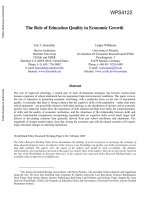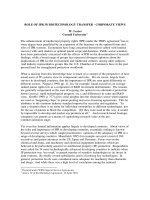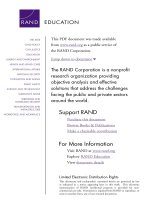Role of microbes in petroleum Hydrocarbon degradation in the aquatic environment: A review
Bạn đang xem bản rút gọn của tài liệu. Xem và tải ngay bản đầy đủ của tài liệu tại đây (427.09 KB, 14 trang )
Int.J.Curr.Microbiol.App.Sci (2020) 9(5): 2990-2903
International Journal of Current Microbiology and Applied Sciences
ISSN: 2319-7706 Volume 9 Number 5 (2020)
Journal homepage:
Review Article
/>
Role of Microbes in Petroleum Hydrocarbon Degradation in the Aquatic
Environment: A Review
David Waikhom1*, Soibam Ngasotter1, Laishram Soniya Devi2,
Manoharmayum Shaya Devi3 and Asem Sanjit Singh2
1
College of Fisheries, Central Agricultural University (Imphal),
Lembucherra, Tripura-799210, India
3
ICAR-Central Inland Fisheries Research Institute (CIFRI), Barrackpore-700120, India
2
ICAR-Central Institute of Fisheries Education (CIFE), Mumbai-400061, India
*Corresponding author
ABSTRACT
Keywords
Enzymes, Microbial
degradation, Oil
spill, Petroleum
hydrocarbon
Article Info
Accepted:
23 April 2020
Available Online:
10 May 2020
The phenomenon of the oil spill in the marine ecosystem is one of the major issues
which causes the introduction of petroleum hydrocarbon pollutants and leads to a
significant threat to the environment. It can occur either naturally or from
anthropogenic sources such as those caused by tanker accidents, refineries, drilling
operations, or even storage facilities. This causes significant damage to both the
habitat and the organisms living in the marine environment. Bioremediation by oildegrading microorganisms is a viable option to metabolize and remove these harmful
pollutants from the polluted site. Oil degrading microorganisms are ubiquitously
distributed in the environment and naturally biodegrade petroleum hydrocarbon. This
review highlights the mechanism of microbial degradation of petroleum hydrocarbons
by enzyme catalytic activities of microorganisms to increase the rate of petroleum
hydrocarbon degradation. It also highlights the factors that affect the biodegradation of
petroleum hydrocarbons by the microorganisms.
Introduction
Oil pollution has been one of the major
challenges to fight climate change in the
world, particularly the aquatic marine
ecosystem. The increase in pollution is a
threat to the marine ecosystem and it also
alters the balance of both the habitat and the
organisms that live there. These organisms
experience altered growth and reproduction
patterns, anatomical complications, and
increased susceptibility to hypothermia.
The majority of the oil pollution relates to the
large numbers of spills, both large and small,
being recorded every year. The impact on the
environment in response to oil pollution with
geographical
isolation
and
extreme
2890
Int.J.Curr.Microbiol.App.Sci (2020) 9(5): 2990-2903
conditions, making any response logistically
challenging. The Gulf War oil spill of Kuwait
is the largest marine oil spill in the world
(Abbriano et al., 2011) that significantly
threat to the marine environment. It was
estimated that the Exxon Valdez oil spill of
1989 and Deepwater Horizon (DWH) oil spill
of 2010 discharged 11 million gallons of
Alaskan North Slope crude oil and 4.9 million
barrels of South Louisiana sweet crude oil
into the Gulf of Mexico respectively resulting
in huge contribution in term of polluting the
marine ecosystem (Bragg et al., 1994). There
are different techniques for the removal of
pollutants and the use of microbe is a viable
option as compared to conventional physicochemical methods and became economically
viable. This review will highlight the
microbial
degradation
of
petroleum
hydrocarbon and also how the microbes
interact with the environment regarding the
mechanisms
involved
under
aerobic
conditions.
Composition of petroleum hydrocarbon
Recent advances in ultra-high-resolution mass
spectrometry have allowed the identification
of more than 17,000 distinct chemical
components which made more complex and
term as petroleomics. Crude oil can be
classified into four main defined groups of
chemicals: (a)the saturated hydrocarbons, (b)
aromatic hydrocarbons, (c) the resins, and (d)
the asphaltenes. Heavy oils contain lower
saturated and aromatic hydrocarbons and a
higher proportion o������������������������������������������������������������������������������������������������������������������������������������������������������������������������������������������������������������������������������������������������������������������������������������������������������������������������������������������������������������������������������������������������������������������������������������������������������������������������������������������������������������������������������������������������������������������������������������������������������������������������������������������������������������������������������������������������������������������������������������������������������������������������������������������������������������������������������������������������������������������������������������������������������������������������������������������������������������������������������������������������������������������������������������������������������������������������������������������������������������������������������������������������������������������������������������������������������������������������������������������������������������������������������������������������������������������������������������������������������������������������������������������������������������������������������������������������������������������������������������������������������������������������������������������������������������������������������������������������������������������������������������������������������������������������������������������������������������������������������������������������������������������������������������������������������������������������������������������������������������������������������������������������������������������������������������������������������������������������������������������������������������������������������������������������������������������������������������������������������������������������������������������������������������������������������������������������������������������������������������������������������������������������������������������������������������������������������������������������������������������������������������������������������������������������������������������������������������������������������������������������������������������������������������������������������������������������������������������������������������������������������������������������������������������������������������������������������������������������������������������������������������������������������������������������������������������������������������������������������������������������������������������������������������������������������������������������������������������������������������������������������������������������������������������������������������������������������������������������������������������������������������������������������������������������������������������������������������������������������������������������������������������������������������������������������������������������������������������������������������������������������������������������������������������������������������������������������������������������������������������������������������������������������������������������������������������������������������������������������������������������������������������������������������������������������������������������������������������������������������������������������������������������������������������������������������������������������������������������������������������������������������������������������������������������������������������������������������������������������������������������������������������������������������������������������������������������������������������������������������������������������������������������������������������������������������������������������������������������������������������������������������������������������������������������������������������������������������������������������������������������������������������������������������������������������������������������������������������������������������������������������������������������������������������������������������������������������������������������������������������������������������������������������������������������������������������������������������������������������������������������������������������������������������������������������������������������������������������������������������������������������������������������������������������������������������������������������������������������������������������������������������������������������������������������������������������������������������������������������������������������������������������������������������������������������������������������������������������������������������������������������������������������������������������������������������������������������������������������������������������������������������������������������������������������������������������������������������������������������������������������������������������������������������������������������������������������������������������������������������������������������������������������������������������������������������������������������������������������������������������������������������������������������������������������������������������������������������������������������������������������������������������������������������������������������������������������������������������������������������������������������������������������������������������������������������������������������������������������������������������������������������������������������������������������������������������������������������������������������������������������������������������������������������������������������������������������������������������������������������������������������������������������������������������������������������������������������������������������������������������������������������������������������������������������������������������������������������������������������������������������������������������������������������������������������������������������������������������������������������������������������������������������������������������������������������������������������������������������������������������������������������������������������������������������������������������������������������������������������������������������������������������������������������������������������������������������������������������������������������������������������������������������������������������������������������������������������������������������������������������������������������������������������������������������������������������������������������������������������������������������������������������������������������������������������������������������������������������������������������������������������������������������������������������������������������������������������������������������������������������������������������������������������������������������������������������������������������������������������������������������������������������������������������������������������������������������������������������������������������������������������������������������������������������������������������������������������������������������������������������������������������������������������������������������������������������������������������������������������������������������������������������������������������������������������������������������������������������������������������������������������������������������������������������������������������������������������������������������������������������������������������������������������������������������������������������������������������������������������������������������������������������������������������������������������������������������������������������������������������������������������������������������������������������������������������������������������������������������������������������������������������������������������������������������������������������������������������������������������������������������������������������������������������������������������������������������������������������������������������������������������������������������������������������������������������������������������������������������������������������������������������������������������������������������������������������������������������������������������������������������������������������������������������������������������������������������������������������������������������������������������������������������������������������������������������������������������������������������������������������������������������������������������������������������������������������������������������������������������������������������������������������������������������������������������������������������������������������������������������������������������������������������������������������������������������������������������������������������������������������������������������������������������������������������������������������������������������������������������������������������������������������������������������������������������������������������������������������������������������������������������������������������������������������������������������������������������������������������������������������������������������������������������������������������������������������������������������������������������������������������������������������������������������������������������������������������������������������������������������������������������������������������������������������������������������������������������������������������������������������������������������������������������������������������������������������������������������������������������������������������������������������������������������������������������������������������������������������������������������������������������������������������������������������������������������������������������������������������������������������������������������������������������������������������������������������������������������������������������������������������������������������������������������������������������������������������������������������������������������������������������������������������������������������������������������������������������������������������������������������������������������������������������������������������������������������������������������������������������������������������������������������������������������������������������������������������������������������������������������������������������������������������������������������������������������������������������������������������������������������������������������������������������������������������������������������������������������������������������������������������������������������������������������������������������������������������������������������������������������������������������������������������������������������������������������������������������������������������������������������������������������������������������������������������������������������������������������������������������������������������������������������������������������������������������������������������������������������������������������������������������������������������������������������������������������������������������������������������������������������������������������������������������������������������������������������������������������������������������������������������������������������������������������������������������������������������������������������������������������������������������������������������������������������������������������������������������������������������������������������������������������������������������������������������������������������������������������������������������������������������������������������������������������������������������������������������������������������������������������������������������������������������������������������������������������������������������������������������������������������������������������������������������������������������������������������������������������������������������������������������������������������������������������������������������������������������������������������������������������������������������������������������������������������������������������������������������������������������������������������������������������������������������������������������������������������������������������������������������������������������������������������������������������������������������������������������������������������������������������������������������������������������������������������������������������������������������������������������������������������������������������������������������������������������������������������������������������������������������������������������������������������������������������������������������������������������������������������������������������������������������������������������������������������������������������������������������������������������������������������������������������������������������������������������������������������������������������������������������������������������������������������������������������������������������������������������������������������������������������������������������������������������������������������������������������������������������������������������������������������������������������������������������������������������������������������������������������������������������������������������������������������������������������������������������������������������������������������������������������������������������������������������������������������������������������������������������������������������������������������������������������������������������������������������������������������������������������������������������������������������������������������������������������������������������������������������������������������������������������������������������������������������������������������������������������������������������������������������������������������������������������������������������������������������������������������������������������������������������������������������������������������������������������������������������������������������������������������������������������������������������������������������������������������������������������������������������������������������������������������������������������������������������������������������������������������������������������������������������������������������������������������������������������������������������������������������������������������������������������������������������������������������������������������������������������������������������������������������������������������������������������������������������������������������������������������������������������������������������������������������������������������������������������������������������������������������������������������������������������������������������������������������������������������������������������������������������������������������������������������������������������������������������������������������������������������������������������������������������������������������������������������������������������������������������������������������������������������������������������������������������������������������������������������������������������������������������������������������������������������������������������������������������������������������������������������������������������������������������������������������������������������������������������������������������������������������������������������������������������������������������������������������������������������������������������������������������������������������������������������������������������������������������������������������������������������������������������������������������������������������������������������������������������������������������������������������������������������������������������������������������������������������������������������������������������������������������������������������������������������������������������������������������������������������������������������������������������������������������������������������������������������������������������������������������������������������������������������������������������������������������������������������������������������������������������������������������������������������������������������������������������������������������������������������������������������������������������������������������������������������������������������������������������������������������������������������������������������������������������������������������������������������������������������������������������������������������������������������������������������������������������������������������������������������������������������������������������������������������������������������������������������������������������������������������������������������������������������������������������������������������������������������������������������������������������������������������������������������������������������������������������������������������������������������������������������������������������������������������������������������������������������������������������������������������������������������������������������������������������������������������������������������������������������������������������������������������������������������������������������������������������������������������������������������������������������������������������������������������������������������������������������������������������������������������������������������������������������������������������������������������������������������������������������������������������������������������������������������������������������������������������������������������������������������������������������������������������������������������������������������������������������������������������������������������������������������������������������������������������������������������������������������������������������������������������������������������������������������������������������������������������������������������������������������������������������������������������������������������������������������������������������������������������������������������������������������������������������������������������������������������������������������������������������������������������������������������������������������������������������������������������������������������������������������������������������������������������������������������������������������������������������������������������������������������������������������������������������������������������������������������������������������������������������������������������������������������������������������������������������������������������������������������������������������������������������������������������������������������������������������������������������������������������������������������������������������������������������������������������������������������������������������������������������������������������������������������������������������������������������������������������������������������������������������������������������������������������������������������������������������������������������������������������������������������������������������������������������������������������������������������������������������������������������������������������������������������������������������������������������������������������������������������������������������������������������������������������������������������������������������������������������������������������������������������������������������������������������������������������������������������������������������������������������������������������������������������������������������������������������������������������������������������������������������������������������������������������������������������������������������������������������������������������������������������������������������������������������������������������������������������������������������������������������������������������������������������������������������������������������������������������������������������������������������������������������������������������������������������������������������������������������������������������������������������������������������������������������������������������������������������������������������������������������������������������������������������������������������������������������������������������������������������������������������������������������������������������������������������������������������������������������������������������������������������������������������������������������������������������������������������������������������������������������������������������������������������������������������������������������������������������������������������������������������������������������������������������������������������������������������������������������������������������������������������������������������������������������������������������������������������������������������������������������������������������������������������������������������������������������������������������������������������������������������������������������������������������������������������������������������������������������������������������������������������������������������������������������������������������������������������������������������������������������������������������������������������������������������������������������������������������������������������������������������������������������������������������������������������������������������������������������������������������������������������������������������������������������������������������������������������������������������������������������������������������������������������������������������������������������������������������������������������������������������������������������������������������������������������������������������������������������������������������������������������������������������������������������������������������������������������������������������������������������������������������������������������������������������������������������������������������������������������������������������������������������������������������������������������������������������������������������������������������������������������������������������������������������������������������������������������������������������������������������������������������������������������������������������������������������������������������������������������������������������������������������������������������������������������������������������������������������������������������������������������������������������������������������������������������������������������������������������������������������������������������������������������������������������������������������������������������������������������������������������������������������������������������������������������������������������������������������������������������������������������������������������������������������������������������������������������������������������������������������������������������������������������������������������oil.
Nature
Reviews
Microbiology, 4(3): 173-182.
Hara, A., Syutsubo, K., and Harayama, S.,
2003. Alcanivorax which prevails in
oil‐ contaminated seawater exhibits
broad substrate specificity for alkane
degradation.
Environmental
Microbiology, 5(9): 746-753.
Hedlund, B. P., Geiselbrecht, A. D., Bair, T.
J., and Staley, J. T., 1999. Polycyclic
aromatic hydrocarbon degradation by a
new marine bacterium, Neptunomonas
naphthovorans gen. nov., sp. nov.
Applied
and
Environmental
Microbiology, 65(1): 251-259.
Hommel, R.K., 1997. Formation and
physiological role of biosurfactants
produced by hydrocarbon-utilizing
microorganisms.
Physiology
of
Biodegradative Microorganisms, pp.
107-119
Iida, T., Sumita, T., Ohta, A., and Takagi, M.,
2000. The cytochrome P450ALK
multigene
family
of
an
n‐ alkane‐ assimilating
yeast,
Yarrowiali polytica: cloning and
characterization of genes coding for
new CYP52 family members. Yeast,
16(12): 1077-1087.
Jagadevan, S. and Mukherji, S., 2004.
Successful in situ oil bioremediation
programmes-Key parameters. Indian
Journal of Biotechnology, 3: 495-501.
Jahromi, H., Fazaelipoor, M. H., Ayatollahi,
S., and Niazi, A., 2014. Asphaltenes
biodegradation under shaking and static
conditions. Fuel, 117: 230-235.
Jain, P.K., Gupta, V.K., Gaur, R.K., Lowry,
M., Jaroli, D.P. and Chauhan, U.K.,
2011. Bioremediation of petroleum oil
contaminated soil and water. Research
Journal of Environmental Toxicology,
5(1): 1-26.
Joshi, B. and Walia, S., 1996. PCR
amplification of catechol 2, 3dioxygenase gene sequences from
naturally
occurring
hydrocarbon
degrading bacteria isolated from
petroleum hydrocarbon contaminated
groundwater. FEMS Microbiology
Ecology, 19(1): 5-15.
Kadri, T., Rouissi, T., Magdouli, S., Brar,
S.K., Hegde, K., Khiari, Z., Daghrir, R.
and Lauzon, J.M., 2018. Production and
characterization of novel hydrocarbon
degrading enzymes from Alcanivorax
borkumensis. International Journal of
Biological Macromolecules, 112: 230240.
Kasai, Y., Kishira, H., and Harayama, S.,
2002. Bacteria belonging to the genus
Cycloclasticus play a primary role in the
degradation of aromatic hydrocarbons
released in a marine environment.
Applied
and
Environmental
Microbiology, 68(11): 5625-5633.
Kavitha, V., Mandal, A.B. and Gnanamani,
A., 2014. Microbial biosurfactant
mediated removal and/or solubilization
of crude oil contamination from soil and
aqueous phase: an approach with
Bacillus licheniformis MTCC 5514.
International Biodeterioration and
Biodegradation, 94: 24-30.
Kraiselburd, I., Brüls, T., Heilmann, G.,
Kaschani, F., Kaiser, M. and
Meckenstock, R.U., 2019. Metabolic
reconstruction of the genome of
candidate Desulfatiglans TRIP_1 and
identification of key candidate enzymes
for anaerobic phenanthrene degradation.
Environmental Microbiology, 21(4):
2899
Int.J.Curr.Microbiol.App.Sci (2020) 9(5): 2990-2903
1267-1286.
Lee, E. H., and Cho, K. S., 2008.
Characterization of cyclohexane and
hexane degradation by Rhodococcus sp.
EC1. Chemosphere, 71(9): 1738-1744.
Leahy, J.G. and Colwell, R.R., 1990.
Microbial degradation of hydrocarbons
in the environment. Microbiology and
Molecular Biology Reviews, 54(3): 305315.
Ma, Y. L., Lu, W., Wan, L. L., and Luo, N.,
2015. Elucidation of fluoranthene
degradative characteristics in a newly
isolated Achromobacter xylosoxidans
DN002. Applied Biochemistry and
Biotechnology, 175(3): 1294-1305.
Megharaj,
M.,
Ramakrishnan,
B.,
Venkateswarlu, K., Sethunathan, N. and
Naidu, R., 2011. Bioremediation
approaches for organic pollutants: a
critical
perspective.
Environment
international, 37(8): 1362-1375.
Minai-Tehrani, D., Herfatmanesh, A., AzariDehkordi, F. and Minuoi, S., 2006.
Effect of salinity on biodegradation of
aliphatic fractions of crude oil in soil.
Pakistan
Journal
of
Biological
Sciences, 9(8): 1531-5.
Mnif, S., Sayadi, S., &Chamkha, M., 2014.
Biodegradative
potential
and
characterization of a novel aromaticdegrading bacterium isolated from a
geothermal oil field under saline and
thermophilic conditions. International
Biodeterioration and Biodegradation,
86: 258-264.
Mulligan, C.N., 2005. Environmental
applications
for
biosurfactants.
Environmental Pollution, 133(2): 183198.
Mukherjee, S., Bardolui, N. K., Karim, S.,
Patnaik, V. V., Nandy, R. K., and Bag,
P.
K.,
2010.
Isolation
and
characterization of a monoaromatic
hydrocarbon-degrading
bacterium,
Pseudomonas aeruginosa from crude
oil. Journal of Environmental Science
and Health Part A, 45(9): 1048-1053.
Okpokwasili, G.C. and Amanchukwu, S.C.,
1988.
Petroleum
hydrocarbon
degradation by Candida species.
Environment International, 14(3): 243247.
Pilon-Smits, E., 2005. Phytoremediation.
Annual Review of Plant Biology, 56: 1539.
Rabiei, A., Sharifinik, M., Niazi, A.,
Hashemi, A. and Ayatollahi, S., 2013.
Core flooding tests to investigate the
effects of IFT reduction and wettability
alteration on oil recovery during MEOR
process in an Iranian oil reservoir.
Applied
microbiology
and
biotechnology, 97(13): 5979-5991.
Rahman, K.S., Rahman, T.J., Kourkoutas, Y.,
Petsas, I., Marchant, R. and Banat, I.M.,
2003. Enhanced bioremediation of nalkane in petroleum sludge using
bacterial consortium amended with
rhamnolipid
and
micronutrients.
Bioresource technology, 90(2): 159168.
Rontani, J.F. and Bonin, P., 2011. Production
of pristane and phytane in the marine
environment: role of prokaryotes.
Research in microbiology, 162(9): 923933.
Ruberto, L., Vazquez, S.C. and Mac
Cormack, W.P., 2003. Effectiveness of
the
natural
bacterial
flora,
biostimulation and bioaugmentation on
the bioremediation of a hydrocarbon
contaminated
Antarctic
soil.
International Biodeterioration and
Biodegradation, 52(2): 115-125.
Saeki, H., Sasaki, M., Komatsu, K., Miura, A.
and Matsuda, H., 2009. Oil spill
remediation by using the remediation
agent JE1058BS that contains a
biosurfactant produced by Gordonia sp.
strain
JE-1058.
Bioresource
Technology, 100(2): 572-577.
2900
Int.J.Curr.Microbiol.App.Sci (2020) 9(5): 2990-2903
Scheller, U., Zimmer, T., Becher, D.,
Schauer, F. and Schunck, W.H., 1998.
Oxygenation cascade in conversion of
n-alkanes to α, ω-dioic acids catalyzed
by cytochrome P450 52A3. Journal of
Biological Chemistry, 273(49): 3252832534.
Schwarz, J.R., Walker, J.D. and Colwell,
R.R., 1975. Deep-sea bacteria: growth
and utilization of n-hexadecane at in
situ temperature and pressure. Canadian
Journal of Microbiology, 21(5): 682687.
Souza, E.C., Vessoni-Penna, T.C. and de
Souza
Oliveira,
R.P.,
2014.
Biosurfactant-enhanced
hydrocarbon
bioremediation:
An
overview.
International biodeterioration and
biodegradation, 89: 88-94.
Sugiura, K., Ishihara, M., Shimauchi, T., and
Harayama, S., 1996. Physicochemical
properties and biodegradability of crude
oil. Environmental Science and
Technology, 31(1): 45-51.
Tao, X., 2019. Identification of Petroleum
Degrading Bacteria and Construction of
Petroleum Degrading Agent. Open
Access Library Journal, 6(04): 1-10.
Tavassoli, T., Mousavi, S. M., Shojaosadati,
S. A., and Salehizadeh, H., 2012.
Asphaltene
biodegradation
using
microorganisms isolated from oil
samples. Fuel, 93: 142-148.
Toda, H., and Itoh, N., 2012. Isolation and
characterization of styrene metabolism
genes from styrene-assimilating soil
bacteria Rhodococcus sp. ST-5 and ST10. Journal of Bioscience and
Bioengineering, 113(1): 12-19.
Tong, K., Zhang, Y., Liu, G., Ye, Z. and Chu,
P.K., 2013. Treatment of heavy oil
wastewater by a conventional activated
sludge process coupled with an
immobilized
biological
filter.
International Biodeterioration and
Biodegradation, 84: 65-71.
Towell, M.G., Paton, G.I. and Semple, K.T.,
2011. The biodegradation of cable oil
components:
Impact
of
oil
concentration, nutrient addition and
bioaugmentation.
Environmental
pollution, 159(12):3777-3783.
Van Beilen, J. B., Li, Z., Duetz, W. A., Smits,
T. H. M., and Witholt, B., 2003.
Diversity of alkane hydroxylase systems
in the environment. Oil &Gas Science
and Technology, 58(4): 427-440.
Van Beilen, J.B. and Funhoff, E.G., 2005.
Expanding the alkane oxygenase
toolbox: new enzymes and applications.
Current Opinion in Biotechnology,
16(3): 308-314.
Van Beilen, J.B. and Funhoff, E.G., 2007.
Alkane hydroxylases involved in
microbial alkane degradation. Applied
microbiology and biotechnology, 74(1):
13-21.
Varjani, S.J., 2014. Hydrocarbon degrading
and biosurfactants (bio-emulsifiers)
producing bacteria from petroleum oil
wells (Doctoral dissertation, PhD thesis,
Kadi
Sarva
Vishwavidyalaya,
Gandhinagar, India).
Varjani, S., THAKER, M. and Upasani, V.,
2014.
Optimization
of
growth
conditions of native hydrocarbon
utilizing bacterial consortium “HUBC”
obtained from petroleum pollutant
contaminated sites. Indian Journal of
Applied Research, 4(10): 474-476.
Varjani, S.J., Rana, D.P., Bateja, S., Sharma,
M.C. and Upasani, V.N., 2014.
Screening
and
identification
of
biosurfactant (bioemulsifier) producing
bacteria from crude oil contaminated
sites of Gujarat, India. International
Journal of Innovative Research in
Science, Engineering and Technology.
3(2): 9205–9213.
Varjani, S.J. and Upasani, V.N., 2016. Carbon
spectrum utilization by an indigenous
strain of Pseudomonas aeruginosa
2901
Int.J.Curr.Microbiol.App.Sci (2020) 9(5): 2990-2903
NCIM
5514:
Production,
characterization and surface active
properties of biosurfactant. Bioresource
Technology, 221: 510-516.
Varjani, S.J., 2017. Microbial degradation of
petroleum hydrocarbons. Bioresource
Technology, 223: 277-286.
Varjani, S.J. and Upasani, V.N., 2017. A new
look on factors affecting microbial
degradation of petroleum hydrocarbon
pollutants.
International
Biodeterioration and Biodegradation,
120: 71-83.
Venkateswaran, K., Hoaki, T., Kato, M., and
Maruyama, T., 1995. Microbial
degradation of resins fractionated from
Arabian light crude oil. Canadian
Journal of Microbiology, 41(4-5): 418424.
Wang, X. B., Chi, C. Q., Nie, Y., Tang, Y. Q.,
Tan, Y., Wu, G., and Wu, X. L., 2011.
Degradation of petroleum hydrocarbons
(C6–C40) and crude oil by a novel
Dietzia strain. Bioresource Technology,
102(17): 7755-7761.
Waigi, M.G., Kang, F., Goikavi, C., Ling, W.
and Gao, Y., 2015. Phenanthrene
biodegradation by sphingomonads and
its application in the contaminated soils
and sediments: a review. International
Biodeterioration and Biodegradation,
104: 333-349.
Walworth, J., Pond, A., Snape, I., Rayner, J.,
Ferguson, S. and Harvey, P., 2005. Fine
tuning soil nitrogen to maximize
petroleum bioremediation. Assessment
and remediation contaminated sites in
Arctic and cold climates (ARCSACC),
251:251-255.
Walworth, J., Pond, A., Snape, I., Rayner, J.,
Ferguson, S., and Harvey, P., 2007.
Nitrogen requirements for maximizing
petroleum bioremediation in a subAntarctic soil. Cold Regions Science
and Technology, 48(2): 84-91.
Xu, X., Liu, W., Tian, S., Wang, W., Qi, Q.,
Jiang, P., Gao, X., Li, F., Li, H. and Yu,
H., 2018. Petroleum hydrocarbondegrading bacteria for the remediation
of oil pollution under aerobic
conditions: a perspective analysis.
Frontiers in Microbiology, 9:1-11.
Yakimov, M.M., Giuliano, L., Gentile, G.,
Crisafi, E., Chernikova, T.N., Abraham,
W.R., Lünsdorf, H., Timmis, K.N. and
Golyshin,
P.N.,
2003.
Oleispiraantarctica gen. nov., sp. nov.,
a novel hydrocarbonoclastic marine
bacterium isolated from Antarctic
coastal sea water. International Journal
of Systematic and Evolutionary
Microbiology, 53(3): 779-785.
Yakimov, M.M., Timmis, K.N. and Golyshin,
P.N. (2007). Obligate oil-degrading
marine bacteria. Current Opinion in
Biotechnology, 18(3): 257-266.
Yalçin, E., Çavuşoğlu, K. and Özen, E., 2011.
Hydrocarbon degradation by a new
Pseudomonas sp., strain RW-II, with
polycationic surfactant to modify the
cell hydrophobicity. Environmental
technology, 32(15): 1743-1747.
Yan, P., Lu, M., Yang, Q., Zhang, H.L.,
Zhang, Z.Z. and Chen, R., 2012. Oil
recovery from refinery oily sludge using
a rhamnolipid biosurfactant-producing
Pseudomonas. Bioresource technology,
116: 24-28.
Yang, Y., Liu, Y., Li, N., Shi, K., Xue, J.,
Gao, Y. and Xiao, X., 2020. Isolation,
enhanced growth, and degradation
characterization of a strain marine
petroleum
degrading
bacteria.
Environmental
Technology
and
Innovation, pp.100796.
Zhang, L., Zhang, C., Cheng, Z., Yao, Y., and
Chen, J., 2013. Biodegradation of
benzene, toluene, ethylbenzene, and oxylene by the bacterium Mycobacterium
cosmeticum byf-4. Chemosphere, 90(4):
1340-1347.
Zhao, F., Zhou, J.D., Ma, F., Shi, R.J., Han,
2902
Int.J.Curr.Microbiol.App.Sci (2020) 9(5): 2990-2903
S.Q., Zhang, J. and Zhang, Y., 2016.
Simultaneous inhibition of sulfatereducing bacteria, removal of H2S and
production
of
rhamnolipid
by
recombinant Pseudomonas stutzeriRhl:
applications for microbial enhanced oil
recovery. Bioresource Technology, 207:
24-30.
Zhukov, D. V., Murygina, V. P.,
&Kalyuzhnyi, S. V., 2007. Kinetics of
the
degradation
of
aliphatic
hydrocarbons
by
the
bacteria
Rhodococcus ruber and Rhodococcus
erythropolis. Applied Biochemistry and
Microbiology, 43(6): 587-592.
How to cite this article:
David Waikhom, Soibam Ngasotter, Laishram Soniya Devi, Manoharmayum Shaya Devi and
Asem Sanjit Singh. 2020. Role of Microbes in Petroleum Hydrocarbon Degradation in the
Aquatic Environment: A Review. Int.J.Curr.Microbiol.App.Sci. 9(05): 2990-2903.
doi: />
2903









